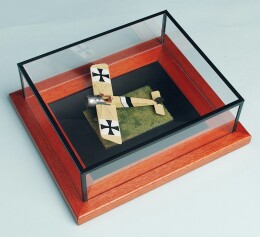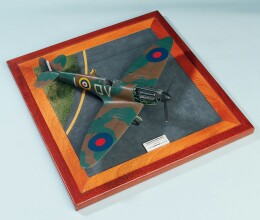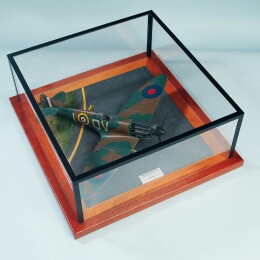Bases and cases
Saturday, 14th May, 2011
There are numerous commercially available display cases, but the better ones tend to be expensive, particularly if they are large enough to house aircraft models in the grander scales. Here’s a simple technique I've used to build my own, and it can be applied over a wide range of finished sizes:
My first step is to laminate a decorative surround onto a 3/4in. thick Chipboard or MDF base. I use hardwood three-ply of about 1/8 inch thick, or less (the kind you can get in metre-length sheets at hobby shops). For a large case I appropriate the entire width of the 'plank', around 4 inches, but for smaller cases the sheets can be divided lengthwise, making them go twice as far. Mitring corners in this relatively thin material is easy with care, so long as the knife is razor sharp, and I’ve found that a slight angled undercut helps ensure a snug join. Contact adhesive is as good as any, and it saves time waiting for glue to set, but be sure to be accurate in positioning – once it grabs, it won’t let go. With the surround in position, the next step is to sand its surface silk-smooth, eliminating any irregularities at the joins.
Next I frame the edges of the base with L-section hardwood mouldings (DIY stores stock these) cut with a mitre-saw. The inner face of the moulding determines the outer dimension of the UPVC cover and it also keeps the cover snugly in place. It doesn’t matter if the moulding is slightly too deep for the base because any excess can be planed flush with the underside once the glue is dry. This too is sanded smooth, and for finishing I use three coats of satin varnish with a light rub-down in between. A piece of green baize finishes the underside nicely, or sometimes I cut or turn little hardwood pads, which can be glued under each corner to give a raised-up effect.
By this stage, I’ve created what is effectively a flat-lying 'picture frame'. Now for the bit in the middle on which the model will stand, and here the treatment is up to personal choice. Normally, I cut a raised plinth from 1/2in. or 3/4in. thick MDF and cover it with fabric. Depending on the character of the model, I’ve also used plastics of various colours (black can be effective) and metals, including machine-turned aluminium. But having experimented with effects such as runway surfaces or grass, I’ve come to the conclusion that less is more and that plain, neutral-coloured, fairly coarse-weave cloth takes some beating for simplicity: It looks good and doesn’t detract the eye from the model.
Now for the cover: I use Perspex or alternatively UPVC sheet sold for double-glazing. The latter is easy to obtain and about 3/16 in. thick, which is nice and rigid; but for smaller cases, thinner material will suffice. UPVC can be cut like glass by scoring and snapping, although the edges invariably need tidying up with a rasp. Great care is needed when handling these materials, since they scratch easily, even with the protective film still in place. I join the four sides and top sheets together with adhesive and tiny wood screws, using a slow-speed mini-drill to make the holes. Contact adhesive alone suffices for small cases and thinner material.
The final stage is to finish the corners of the cover, and here I use black plastic L-section, which also can be purchased in various sizes at DIY stores. This strengthens the joins significantly and also conceals the raw edges of the UPVC and attendant fixings. For a really neat job, the inside corners can be treated in the same way, but the geometry of the thing means you have to use L-section of a smaller size. But again, great care is needed: I’ve found to my cost that any excess or spilt glue is almost impossible to polish out.
As a finishing touch I sometimes add a little name plaque. I create the words on my Apple Mac, and print them onto clear acetate, which I laminate onto a rectangular blank of alloy or brass using appropriate clear adhesive. So long as no air bubbles are trapped the glue becomes quite invisible when dry.




